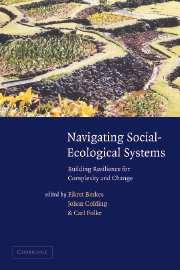Book contents
- Frontmatter
- Contents
- List of contributors
- Preface
- Acknowledgements
- Foreword: The backloop to sustainability
- 1 Introduction
- Part I Perspectives on resilience
- Part II Building resilience in local management systems
- Part III Social-ecological learning and adaptation
- Part IV Cross-scale institutional response to change
- 11 Dynamics of social–ecological changes in a lagoon fishery in southern Brazil
- 12 Keeping ecological resilience afloat in cross-scale turbulence: an indigenous social movement navigates change in Indonesia
- 13 Policy transformations in the US forest sector, 1970–2000: implications for sustainable use and resilience
- 14 Synthesis: building resilience and adaptive capacity in social–ecological systems
- Index
- References
11 - Dynamics of social–ecological changes in a lagoon fishery in southern Brazil
Published online by Cambridge University Press: 13 August 2009
- Frontmatter
- Contents
- List of contributors
- Preface
- Acknowledgements
- Foreword: The backloop to sustainability
- 1 Introduction
- Part I Perspectives on resilience
- Part II Building resilience in local management systems
- Part III Social-ecological learning and adaptation
- Part IV Cross-scale institutional response to change
- 11 Dynamics of social–ecological changes in a lagoon fishery in southern Brazil
- 12 Keeping ecological resilience afloat in cross-scale turbulence: an indigenous social movement navigates change in Indonesia
- 13 Policy transformations in the US forest sector, 1970–2000: implications for sustainable use and resilience
- 14 Synthesis: building resilience and adaptive capacity in social–ecological systems
- Index
- References
Summary
Introduction
Any resource management system has two interrelated dimensions: the social system and the ecological system. These dimensions are often treated separately. In the last decades, considering the failure of many conventional resource management systems (Ludwig, Hilborn, and Walters, 1993), some researchers have started investigating the dynamics of integrated social and ecological systems (henceforth social–ecological systems) in order to improve resource management (Gunderson, Holling, and Light, 1995; Berkes and Folke, 1998). To analyze the dynamics of social–ecological systems, we use common-property theory and adaptive management.
The development of common-property theory (McCay and Acheson, 1987; Berkes, 1989; Ostrom, 1990; Bromley, 1992) has provided key tools for the understanding of the social dimension of management systems. A common-property (or common-pool) resource (defined as a class of resources for which exclusion is difficult and joint use involves subtractability) can be managed under four ‘pure’ property rights regimes: communal property (community-based management), state property, private property, or open access (lack of a property rights regime). In reality, many resources are managed under various mixes of these regimes, as in co-management characterized by a sharing of responsibility between the government and user groups for resource management. The degree of participation of government agencies and user groups in the decision-making process may vary greatly from one co-management case to another (McCay and Jentoft, 1996; Pomeroy and Berkes, 1997).
- Type
- Chapter
- Information
- Navigating Social-Ecological SystemsBuilding Resilience for Complexity and Change, pp. 271 - 298Publisher: Cambridge University PressPrint publication year: 2002
References
- 2
- Cited by



